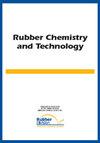从二氧化硅填充的气泡化橡胶中去除锌化合物的处理方法及二氧化硅聚合体的分散分析
IF 1.2
4区 工程技术
Q4 POLYMER SCIENCE
引用次数: 0
摘要
在室温下用二乙醚/盐酸溶液处理充满二氧化硅的橡胶硫化胶 96 小时,可去除大部分小于约 90 nm 的锌化合物,其中包括副产品交联反应产生的大部分残余氧化锌、橡胶可溶性锌化合物和 ZnS。然而,经过这种处理后,仍会残留极少量几微米大小的巨大氧化锌颗粒。在经过 96 小时处理的二氧化硅填充丁苯橡胶基体中,观察到交联密度和杨氏模量显著增加,原因是氯化氢从添加 HCl 的橡胶分子中去除后发生了交联反应。在交联密度增加的同时,最靠近周围两层结合橡胶中二氧化硅的结合橡胶层也增加了,而相同体积的橡胶基体则减少了。由此推断,由于这些体积变化,白炭黑的聚集结构变化不大。另一方面,对处理过的样品进行的 USAXS 测量显示了二氧化硅聚集体产生的肩状结构,并且由于去除了尺寸小于约 90 纳米的锌化合物,获得了清晰的高分辨率 X 射线 CT 图像。这些肩部与通过 X 射线 CT 成像获得的二氧化硅聚集体大小之间的关系在性质上是一致的,并且不受 TESP 和 DPG 存在与否的影响,而是取决于橡胶类型。通过 X 射线 CT 成像测定的二氧化硅聚集体近邻颗粒之间的距离也取决于橡胶类型。本文章由计算机程序翻译,如有差异,请以英文原文为准。
TREATMENT FOR REMOVING Zn COMPOUNDS FROM SILICA-FILLED VULCANIZED RUBBER AND ANALYSIS OF SILICA AGGREGATE DISPERSION
Treatment of silica-filled rubber vulcanizates with a diethyl ether/conc. HCl solution for 96 h at room temperature can remove most Zn compounds smaller than approximately 90 nm, which account for most of the residual ZnO, rubber soluble Zn compounds and ZnS resulting from crosslinking reactions of by-products. However, a very small number of giant ZnO particles of a few μm in size remain after such treatment. In the silica-filled SBR matrix treated for 96 h, a significant increase in crosslink density and Young's modulus was observed due to crosslinking reactions after HCl was removed from HCl-added rubber molecules. This increase in crosslink density was accompanied by an increase in the surrounding layer of bound rubber closest to the silica of the two bound rubber layers around it and a decrease in the rubber matrix of the same volume. It is inferred that there was little change in the aggregate structure of the silica due to these volume changes. On the other hand, USAXS measurements of the treated samples showed shoulders derived from silica aggregates, and clear high-resolution X-ray CT images were obtained due to the removal of Zn compounds smaller than approximately 90 nm in size. The relationship between these shoulders and the size of silica aggregates obtained by X-ray CT imaging was qualitatively consistent, and it was not affected by the presence or absence of TESP and DPG, but was dependent on the rubber type. The distance between nearest neighbor particles of silica aggregates, determined by X-ray CT imaging, also depended on the types of rubber.
求助全文
通过发布文献求助,成功后即可免费获取论文全文。
去求助
来源期刊

Rubber Chemistry and Technology
工程技术-高分子科学
CiteScore
3.50
自引率
20.00%
发文量
21
审稿时长
3.6 months
期刊介绍:
The scope of RC&T covers:
-Chemistry and Properties-
Mechanics-
Materials Science-
Nanocomposites-
Biotechnology-
Rubber Recycling-
Green Technology-
Characterization and Simulation.
Published continuously since 1928, the journal provides the deepest archive of published research in the field. Rubber Chemistry & Technology is read by scientists and engineers in academia, industry and government.
 求助内容:
求助内容: 应助结果提醒方式:
应助结果提醒方式:


